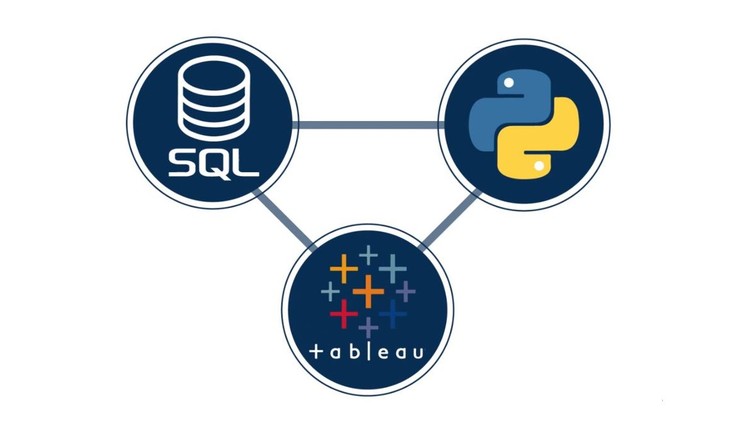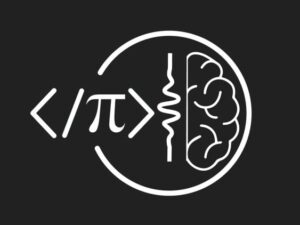Python + SQL + Tableau: Integrating Python, SQL, and Tableau
- Descrição
- Currículo
- FAQ
- Revisões
Python, SQL, and Tableau are three of the most widely used tools in the world of data science.
Python is the leading programming language;
SQL is the most widely used means for communication with database systems;
Tableau is the preferred solution for data visualization;
To put it simply – SQL helps us store and manipulate the data we are working with, Python allows us to write code and perform calculations, and then Tableau enables beautiful data visualization. A well-thought-out integration stepping on these three pillars could save a business millions of dollars annually in terms of reporting personnel.
Therefore, it goes without saying that employers are looking for Python, SQL, and Tableau when posting Data Scientist and Business Intelligence Analyst job descriptions. Not only that, but they would want to find a candidate who knows how to use these three tools simultaneously. This is how recurring data analysis tasks can be automated.
So, in this course we will to teach you how to integrate Python, SQL, and Tableau. An essential skill that would give you an edge over other candidates. In fact, the best way to differentiate your job resume and get called for interviews is to acquire relevant skills other candidates lack. And because, we have prepared a topic that hasn’t been addressed elsewhere, you will be picking up a skill that truly has the potential to differentiate your profile.
Many people know how to write some code in Python.
Others use SQL and Tableau to a certain extent.
Very few, however, are able to see the full picture and integrate Python, SQL, and Tableau providing a holistic solution. In the near future, most businesses will automate their reporting and business analysis tasks by implementing the techniques you will see in this course. It would be invaluable for your future career at a corporation or as a consultant, if you end up being the person automating such tasks.
Our experience in one of the large global companies showed us that a consultant with these skills could charge a four-figure amount per hour. And the company was happy to pay that money because the end-product led to significant efficiencies in the long run.
The course starts off by introducing software integration as a concept. We will discuss some important terms such as servers, clients, requests, and responses. Moreover, you will learn about data connectivity, APIs, and endpoints.
Then, we will continue by introducing the real-life example exercise the course is centered around – the ‘Absenteeism at Work’ dataset. The preprocessing part that follows will give you a taste of how BI and data science look like in real-life on the job situations. This is extremely important because a significant amount of a data scientist’s work consists in preprocessing, but many learning materials omit that
Then we would continue by applying some Machine Learning on our data. You will learn how to explore the problem at hand from a machine learning perspective, how to create targets, what kind of statistical preprocessing is necessary for this part of the exercise, how to train a Machine Learning model, and how to test it. A truly comprehensive ML exercise.
Connecting Python and SQL is not immediate. We have shown how that’s done in an entire section of the course. By the end of that section, you will be able to transfer data from Jupyter to Workbench.
And finally, as promised, Tableau will allow us to visualize the data we have been working with. We will prepare several insightful charts and will interpret the results together.
As you can see, this is a truly comprehensive data science exercise. There is no need to think twice. If you take this course now, you will acquire invaluable skills that will help you stand out from the rest of the candidates competing for a job.
Also, we are happy to offer a 30-day unconditional no-questions-asked-money-back-in-full guarantee that you will enjoy the course.
So, let’s do this! The only regret you will have is that you didn’t find this course sooner!
-
2Properties and Definitions: Data, Servers, Clients, Requests and ResponsesVídeo Aula
-
3Properties and Definitions: Data, Servers, Clients, Requests and ResponsesQuestionário
Which of the following is incorrect?
-
4Properties and Definitions: Data Connectivity, APIs, and EndpointsVídeo Aula
-
5Properties and Definitions: Data Connectivity, APIs, and EndpointsQuestionário
-
6Further Details on APIsVídeo Aula
-
7Further Details on APIsQuestionário
-
8Text Files as Means of CommunicationVídeo Aula
-
9Text Files as Means of CommunicationQuestionário
-
10Definitions and ApplicationsVídeo Aula
-
11Definitions and ApplicationsQuestionário
-
12Setting Up the Environment - An Introduction (Do Not Skip, Please)!Vídeo Aula
-
13Why Python and why Jupyter?Vídeo Aula
-
14Why Python and why Jupyter?Questionário
-
15Installing AnacondaVídeo Aula
-
16The Jupyter Dashboard - Part 1Vídeo Aula
-
17The Jupyter Dashboard - Part 2Vídeo Aula
-
18Jupyter ShortcutsTexto
-
19The Jupyter DashboardQuestionário
-
20Installing sklearnVídeo Aula
-
21Installing Packages - ExerciseTexto
-
22Installing Packages - SolutionTexto
-
28What to Expect from the Next Couple of SectionsTexto
-
29Data Sets in PythonVídeo Aula
-
30Data at a GlanceVídeo Aula
-
31A Note on Our Usage of Terms with Multiple MeaningsVídeo Aula
-
32ARTICLE - A Brief Overview of Regression AnalysisTexto
-
33Picking the Appropriate Approach for the Task at HandVídeo Aula
-
34Removing Irrelevant DataVídeo Aula
-
35EXERCISE - Removing Irrelevant DataTexto
-
36SOLUTION - Removing Irrelevant DataTexto
-
37Examining the Reasons for AbsenceVídeo Aula
-
38Splitting a Column into Multiple DummiesVídeo Aula
-
39EXERCISE - Splitting a Column into Multiple DummiesTexto
-
40SOLUTION - Splitting a Column into Multiple DummiesTexto
-
41ARTICLE - Dummy Variables: ReasoningTexto
-
42Dummy Variables and Their Statistical ImportanceVídeo Aula
-
43Grouping - Transforming Dummy Variables into Categorical VariablesVídeo Aula
-
44Concatenating Columns in PythonVídeo Aula
-
45EXERCISE - Concatenating Columns in PythonTexto
-
46SOLUTION - Concatenating Columns in PythonTexto
-
47Changing Column Order in Pandas DataFrameVídeo Aula
-
48EXERCISE - Changing Column Order in Pandas DataFrameTexto
-
49SOLUTION - Changing Column Order in Pandas DataFrameTexto
-
50Implementing Checkpoints in CodingVídeo Aula
-
51EXERCISE - Implementing Checkpoints in CodingTexto
-
52SOLUTION - Implementing Checkpoint in CodingTexto
-
53Exploring the Initial "Date" ColumnVídeo Aula
-
54Using the "Date" Column to Extract the Appropriate Month ValueVídeo Aula
-
55Introducing "Day of the Week"Vídeo Aula
-
56EXERCISE - Removing ColumnsTexto
-
57Further Analysis of the DataFrame: Next 5 ColumnsVídeo Aula
-
58Further Analysis of the DaraFrame: "Education", "Children", "Pets"Vídeo Aula
-
59A Final Note on PreprocessingVídeo Aula
-
60A Note on Exporting Your Data as a *.csv FileTexto
-
61Exploring the Problem from a Machine Learning Point of ViewVídeo Aula
-
62Creating the Targets for the Logistic RegressionVídeo Aula
-
63Selecting the InputsVídeo Aula
-
64A Bit of Statistical PreprocessingVídeo Aula
-
65Train-test Split of the DataVídeo Aula
-
66Training the Model and Assessing its AccuracyVídeo Aula
-
67Extracting the Intercept and Coefficients from a Logistic RegressionVídeo Aula
-
68Interpreting the Logistic Regression CoefficientsVídeo Aula
-
69Omitting the dummy variables from the StandardizationVídeo Aula
-
70Interpreting the Important PredictorsVídeo Aula
-
71Simplifying the Model (Backward Elimination)Vídeo Aula
-
72Testing the Machine Learning ModelVídeo Aula
-
73How to Save the Machine Learning Model and Prepare it for Future DeploymentVídeo Aula
-
74ARTICLE - More about 'pickling'Texto
-
75EXERCISE - Saving the Model (and Scaler)Texto
-
76Creating a Module for Later Use of the ModelVídeo Aula












